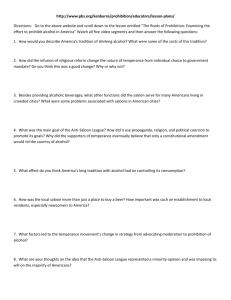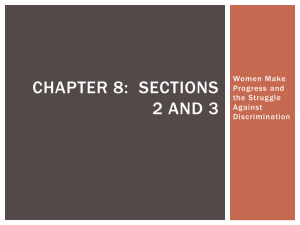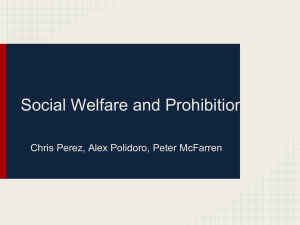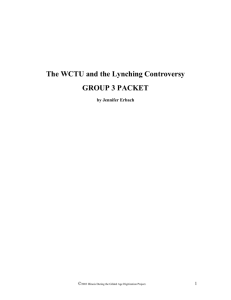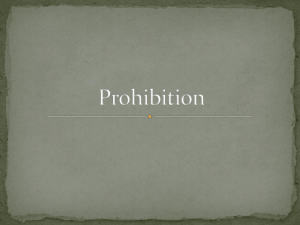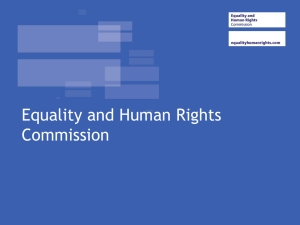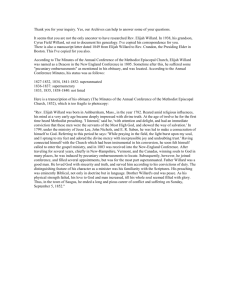Sarah Boyle, The Woman`s Christian Temperance
advertisement
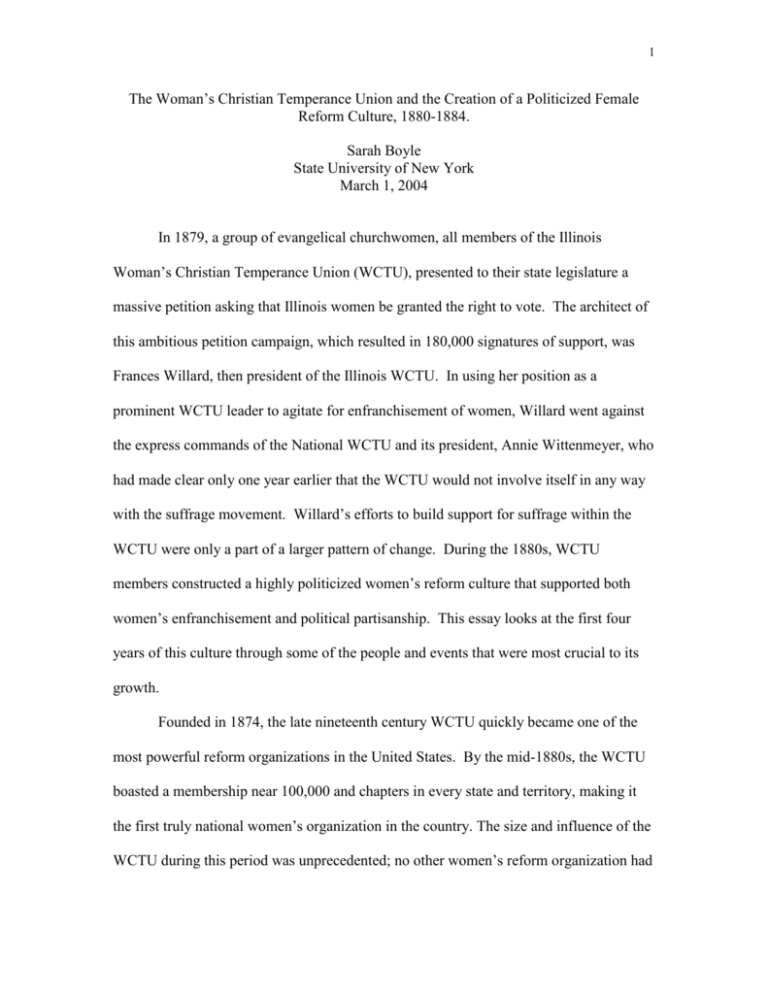
1 The Woman’s Christian Temperance Union and the Creation of a Politicized Female Reform Culture, 1880-1884. Sarah Boyle State University of New York March 1, 2004 In 1879, a group of evangelical churchwomen, all members of the Illinois Woman’s Christian Temperance Union (WCTU), presented to their state legislature a massive petition asking that Illinois women be granted the right to vote. The architect of this ambitious petition campaign, which resulted in 180,000 signatures of support, was Frances Willard, then president of the Illinois WCTU. In using her position as a prominent WCTU leader to agitate for enfranchisement of women, Willard went against the express commands of the National WCTU and its president, Annie Wittenmeyer, who had made clear only one year earlier that the WCTU would not involve itself in any way with the suffrage movement. Willard’s efforts to build support for suffrage within the WCTU were only a part of a larger pattern of change. During the 1880s, WCTU members constructed a highly politicized women’s reform culture that supported both women’s enfranchisement and political partisanship. This essay looks at the first four years of this culture through some of the people and events that were most crucial to its growth. Founded in 1874, the late nineteenth century WCTU quickly became one of the most powerful reform organizations in the United States. By the mid-1880s, the WCTU boasted a membership near 100,000 and chapters in every state and territory, making it the first truly national women’s organization in the country. The size and influence of the WCTU during this period was unprecedented; no other women’s reform organization had 2 ever had its power and scope. For the first time, tens of thousands of women were entering the public sphere as agitators and reformers with a distinctly female agenda. Because this mass influx of reform-minded women into the public sphere was so unprecedented, WCTU leaders were presented with the difficult task of creating a women’s national reform culture literally from scratch. Difficult because, as the early suffrage battles indicated, the membership was as varied as it was large. Many WCTU chapters—especially those in small towns and those in the South—were narrowly focused gospel temperance societies. Using moral suasion (e.g., affecting change through religion and education rather than through politics), these chapters concentrated on ending the sale and manufacture of alcohol at the local level. But other WCTUs— especially those in the North and in urban areas—were highly politicized organizations committed to wide-spread societal reform. WCTU leaders needed to build a national organization that made space for both these extremes. Between 1874 and 1879, the NWCTU was led by Annie Wittenmyer, an ex-Civil War nurse and a staunch anti-suffragist. During her presidency, WCTU women were encouraged to hold prayer meetings, organize and educate children about the dangers of alcohol, circulate temperance pledges, do “home missionary” work among the poor and supposedly intemperate, and make their own homes more attractive in order to counteract the lure of the saloon. 1 Although Wittenmyer voiced the belief that “the world will halt or move in its onward march towards millennial glory, as we [women] halt or march,” she nonetheless cautioned women to be “thoughtful and prayerful” as public agitators and “Plan of Work” Minutes of the First Annual Convention of the National Woman’s Christian Temperance Union Held in Cleveland, Ohio, November 17, 18, and 19, 1874. (Chicago: Woman’s Temperance Publication Association, 1889), 24-28. 1 3 to “walk softly before the Lord.”2 Under her leadership, WCTU women were discouraged from straying very far from the accepted women’s sphere of home, religion, and children. But even in these early years, there were WCTUs engaging in activities that tested the boundaries of temperance women’s activism and suggested the need for a leadership more dynamic than Wittenmyer’s. Although by the end of the century, an impressive array of women’s clubs and organizations had sprung up across the country, in the 1870s, the WCTU was often the only game in town, particularly in the mid and far West. Consequently, the organization was drawing to it talented, educated women with little patience for cautious leadership or “walking softly.” The Portland, Maine WCTU, for example, set up a home for “fallen women.”3 In Cleveland, Ohio, the WCTU founded a “woman’s church,” run by seven “deaconesses” and “no pastor, save the shepardess, who may be delegated by the Union.”4 While pastors from other churches were welcome in the woman’s church, “the sermons are within the ‘Woman’s Kingdom.’”5 Willard and the Illinois WCTU, meanwhile, embarked on their massive petition drive for suffrage. Of all these activities, none made a bigger stir within the WCTU than the Illinois suffrage campaign. In the late 1870s, Americans still viewed woman suffrage as a dangerous and radical reform with the potential to destroy the family and “unsex” “President’s Address,” Minutes of the Fourth Annual Convention of the National Woman’s Christian Temperance Union, Held in Chicago, Ill. October 24, 25, 26, and 27, 1877 (Chicago: Woman’s Temperance Publishing Association, 1889), 136. Wittenmyer reiterated this position in the closing remarks of her 1879 address. As the delegates “map[ped] out for the year the work of one of the largest societies in the world,” Wittenmyer urged them to “walk softly before the Lord and carefully before the people, lest we mar God’s work and cross His plans, and mark out paths that our co-laborers cannot enter.” “President’s Address,” Minutes of the Woman’s National Christian Temperance Union, at the Sixth Annual Meeting, in Indianapolis, October 29th to November 3rd, 1879. (Cleveland: Fairbanks & Co., Printers, 1879), 18. 3 “Corresponding Secretary’s Report” NWCTU Convention, 1877, 182. 4 “Corresponding Secretary’s Report” NWCTU Convention, 1877, 190. 5 “Corresponding Secretary’s Report” NWCTU Convention, 1877, 191. 2 4 women. Willard met these fears and prejudices head on by arguing that women did not seek the vote for their own advancement, but rather to protect their home. This “Home Protection” ballot, as Willard called it, was the key to a more moral, more Christian America. Once enfranchised, according to Willard, women would use their votes to pass prohibition, “blue laws,” and Sunday rest laws, strengthen the public school system, end child labor, raise the age of consent, and otherwise enact legislation they believed would preserve the sanctity of the home and purify society. She also argued that women would vote only for “moral” candidates, thus bringing an end to the corruption and graft that defined Gilded Age politics. Even before her well-publicized push for Home Protection, Willard was a wellknown figure in educational, evangelical, and temperance circles. Before she joined the WCTU, Willard was president of the Northwestern University’s women’s college, one of few women in the country to be appointed to such a post. And for eight months in 1877, she was employed as a lecturer by Dwight Moody, the pre-eminent evangelist of the postCivil War era. She also served as the NWCTU’s corresponding secretary during the 1870s. As secretary, she was in touch with temperance women across the country, urging them to organize WCTU chapters and providing instruction on how to do it. These duties helped her establish a national network of women who were more familiar with her leadership than with Wittenmyer’s. By the late 1870s, therefore, Willard stood before the NWCTU as a charismatic, energetic leader with significant connections and achievements not only in temperance reform, but in education, women’s suffrage, and evangelicalism as well. 5 By late fall, 1879, WCTU women were ready to give Willard’s innovative leadership a try. With a vote of 99 to 40, delegates at the NWCTU convention chose Willard over Wittenmyer as their new national president. And, in annual landslide elections, they would continue to choose her for the next eighteen years. From the beginning of her presidency, Willard worked toward three important goals: One, making the WCTU a truly national organization, with chapters in every state and territory in the United States (by the mid-1880s, this goal had become an international one); two, building support within the WCTU for suffrage; and three, committing the WCTU to the Prohibition party, a fledgling third party that endorsed both prohibition and woman suffrage. None of these goals would be easy to achieve. The WCTU was a virtual non-entity in the South in 1879. And a northern organization that encouraged women towards public speaking and political agitation could hardly expect a warm reception from a culture that considered “Yankee” a coarse epithet and regarded outspoken public women as aberrations. Even in the North, suggesting that “respectable” middle-class women become suffragists and political partisans was apt to meet with derision and harsh criticism. But Willard was determined that political partisanship and enfranchisement would be central to the WCTU agenda. Perhaps the single most important thing Willard did as president was decentralize the NWCTU’s power structure. Under her leadership, the only requirements to maintaining a membership in the NWCTU, as Willard was fond of saying, were payment of dues and the signing of a temperance pledge. Other than that, WCTU women were given considerable freedom to shape their state and local WCTUs as they saw fit. The NWCTU did have extensive departments of work that it expected would guide the work 6 of its auxiliaries, but it did not require them to mimic the national plan of work exactly. This decentralized power structure was important for two main reasons: One, it made the WCTU a highly adaptable organization; North and South, East and West, urban and rural, among immigrants, southern black women, and middle-class, native born white women, unions flourished and grew. Two, it allowed the NWCTU to take bold stands on such issues as political partisanship, labor rights, and suffrage with minimal risk of alienating its auxiliaries. If at any time members expressed apprehension over the National’s activities, they would quickly be reminded that the NWCTU spoke only for itself on controversial issues, not for the various state and local unions. The ideological distance the national union maintained from its auxiliaries was especially important when Willard began to push for NWCTU endorsement of the Prohibition party. In the Gilded Age United States, party politics was an unqualified masculine institution. In large part, the genderization of politics occurred for practical reasons: as disfranchised citizens, women were necessarily outsiders to the political process. But there were other reasons why politics was viewed as an exclusively masculine province. By the 1870s, corruption and spoils were common features of partisan politics, remarkable only in their most egregious form (e.g. the scandals of the Grant administration, or the flagrant patronage of urban political machines). Many Americans simply accepted that party politics were, by their nature, a rough-and-tumble world of compromise and shady morality. As such, partisanship was considered altogether unsuitable for women, who, according to Victorian gender conventions, were naturally moral, religious, and pure. 7 But Willard did not accept that party politics were intrinsically unprincipled or immoral, although she was unstinting in her criticism of the two mainstream parties. The Republican party was “degenerate”; the Democratic party was an “anathema maranatha”6; both were hopelessly corrupt and controlled by “that Cerberus of perdition, the saloon.”7 But the Prohibition party, Willard argued, opposed the liquor industry and its questionable lobbying practices. It opposed “the practical surrender of the souls and bodies of children to the saloon-keeper in return for their votes.” It fought to bring true democracy to America by advocating the full enfranchisement of women. And in doing all this, Willard declared, it became the true embodiment of political party: “the mould into which God pours the principles that are to bless humanity.”8 Thus, in Willard’s construction, partisan wrangling for constituents and elective offices became an epic battle between the servants of Cerberus and the mould of God for the preservation of democracy and the home. By infusing partisan politics with the grandeur of a holy crusade, Willard could then easily argue that partisanship—in the form of endorsing the Prohibition party—was every woman’s Christian duty. And when the Illinois WCTU endorsed the Prohibition party in 1881, Willard declared that they were filled with “the power of the Highest manifest,” and she challenged all WCTU women to “falter who must, follow who dare!”9 Taken as a whole, Willard’s arguments were a bold re-visioning of women’s political power. When Willard began her campaign for the Prohibition party, it was a “President’s Annual Address,” Minutes of the National Woman’s Christian Temperance Union, At the Twelfth Annual Meeting In Philadelphia, PA., October 30 th, 31st and November 2nd and 3rd. (Brooklyn: Martin & Niper, Steam Printers, 1885), 67. “Anathema maranatha” is a biblical phrase taken from 1Cor. 16:22, referring to nonbelievers. 7 “President’s Address,” Tenth Annual Report of the Woman’s Christian Temperance Union of the State of Illinois. For the Year ending October 23, 1883. (Chicago: Union Signal Print, 1883), 23. 8 “Annual Address,” NWCTU Convention, 1881, lxxvii-lxxviii. 6 8 small third party of negligible importance. But it supported both suffrage and prohibition, and it was in desperate need of a large number of dedicated workers who could distribute literature, give speeches, run campaigns, and otherwise raise the party’s profile throughout the country. Willard theorized that WCTU women would be drawn to the party’s platform and the party would welcome the support of a rapidly growing organization of like-minded, politically-active citizens, even if they were all disfranchised. As they worked to increase the Prohibition party’s influence, WCTU women would gain valuable experience as political partisans, all loyal to the same party. In turn, the Prohibition party, once it gained the necessary strength and numbers, would make good on its promise to enfranchise women. Thus, the end result of the WCTU’s endorsement of the Prohibition party would be not only full citizenship rights for women and national prohibition, but also a powerful political party controlled by savvy women voters and, not incidentally, Frances E. Willard. But as Willard began her presidency in 1880, such a sweeping victory must have seemed very far away, and even the achievement of the first step—WCTU endorsement of the Prohibition party—was uncertain. Despite her unflagging encouragement, NWCTU delegates to the annual national conventions remained reluctant to take a stand on partisanship. And even when they did take a stand in 1883, in the form of a resolution (popularly called the “Detroit resolution” after the city that had hosted that year’s convention), they failed to mention the Prohibition party by name, committing themselves only to “lend[ing] our influence to that party, by whatever name called,” that endorsed prohibition. But in 1883, with a presidential election looming just over a year away, Willard took a more aggressive stance in fostering ties between the WCTU and the 9 “Annual Address,” NWCTU Convention, 1881, lxxvii-lxxviii. 9 Prohibition party. That year, Willard introduced the “Great Petition campaign,” which, over the course of the following year, would help build support for the Prohibition party within the WCTU. As Willard initially conceived the campaign, the NWCTU would print up and distribute to all the state unions petitions for a national prohibition amendment. This “plea for Home, Sweet Home” would be circulated throughout the states for signatures by local union members, then presented first to the presidential nominating conventions and finally to Congress by the national officers. By the 1883, the mainstream political parties had rejected stringent prohibition not once but several times. The Democratic party was unapologetically wet, while the Republican party relied on vague language and license laws to avoid the issue. Neither party seemed inclined to alter its position on the controversial subject, especially with a presidential election approaching. The Great Petition campaign, which would bring the national representatives of the WCTU into contact with the national representatives of the respective political parties over the issue of prohibition was a perfect way for Willard to call attention to the intractability of the Democrats and the indecisiveness of the Republicans, while simultaneously gaining support for the Prohibitionists.10 10 The Great Petition campaign hit a serious snag early on when some delegates, including delegates from Illinois, objected to the petition being generally circulated throughout the states before being presented to the parties’ nominating conventions and to Congress. The delegates declared that they had voted in favor of a memorial to be signed by the national officers, and not a petition to be signed by as many people as possible. The confusion lasted for several months, and although Willard and other national officers ultimately concluded that the majority of the delegates had voted for a petition and not a memorial, too much time had elapsed to undertake the time-consuming task of full petition campaign. Thus, to Willard’s considerable disappointment, instead of presenting a petition consisting of hundreds of rolls of paper and hundreds of thousands of names, as she had envisioned, the national officers presented the various parties’ nominating conventions with a much smaller memorial bearing the signatures of the national officers, state presidents, and national superintendents, altogether a little over one hundred names. 10 In the summer of 1884, Willard and the other national officers began the presentation of the petition to the presidential nominating conventions. That year, four parties held conventions: the Democrats, the Republicans, the Prohibitionists, and the Greenbackers. At each convention, the officers, usually led by Willard, made a formal presentation of their petition to the delegates. The reactions of the conventions to the petition and the women themselves were recorded and appeared in the NWCTU newspaper, the Union Signal, throughout the spring and summer of 1884. Willard wrote the report of the Greenback convention, describing the delegates as “thoughtful, earnest men,” a far cry from the “fools or fanatics” described in the “partisan press.” She noted approvingly that at least a dozen of the delegates were women, most of whom gave speeches and all of whom were “models of deportment.” The Greenbackers, Willard wrote, “are friendly to our cause and appreciative toward the work and potentiality of American womanhood.” Upon being presented with the petition, the delegates passed a resolution “in favor of submitting to a vote of the people” amendments for both prohibition and woman suffrage. However, Willard’s general good-will toward the Greenback convention was tempered with some displeasure at the occasional rowdiness of the gathering. “[W]ild gesticulations...seemed a requisite of utterance in the average (masculine) delegate,” and at one point, the convention became “a momentary mob,” with delegates “standing in chairs, waving hats, [and] screaming” for the attention of the Chair.11 No doubt an unsettling image for Union Signal readers, most of whom were women used to the more sedate proceedings of a WCTU convention. “The Women’s Memorial for National Prohibition at the Greenback Convention,” Union Signal, June 5, 1884, 8. 11 11 “Fresh from [the] triumphs in the Greenback convention,” the petitioners next traveled to the Republican national convention. The writer of this report, probably not Willard, was only identified as “One Who Was There.” She described how the delegates grudgingly accepted the petition (an attempt to refer it to committee without reading was ultimately unsuccessful), but that they did vote to extend to Willard fifteen minutes rather than five to address the convention. In the course of her remarks, which the Union Signal printed in full, Willard cautioned her audience that “some political party will respond to this plea from the hearts of women,” and it will be this party for which women will “pray and work, circulate literature, convene assemblies, and do all in our power to secure its success.”12 “And now what was the result” of the Republican convention? asked the Union Signal correspondent. She directed her readers to read the approved platform and note how respectfully this party doffs its hat to the great labor interests of the country, how it bows with servile devotion to manufacturing corporations, agricultural industries, speaks out with no uncertain sound against ‘Chinese cheap labor’ and makes a brave thrust at Mormonism.13 But the platform was “silent as the grave” on the liquor industry, “the great evil” that posed a greater threat to American workers and homes than did capital, “the Mongolian hordes,” or Mormonism. “It is hard to believe,” she continued, “that of all others, the party which wreaked itself on heart-expression in its infancy, has grown so cold to human suffering” in its maturity. With an apparent mixture of reluctance and determination, “One Who Was There” concluded that if indeed “policy now rules where principle first 12 13 “The Memorial at the National Republican Convention,” Union Signal, June 12, 1884, 8-9. “The Memorial at the National Republican Convention,” 9. 12 inspired,” it would be necessary to sacrifice the party that had, in the eyes of the NWCTU officers, clearly lost its way.14 But if the other three major parties received Willard and the Great Petition less than enthusiastically, the Prohibition party welcomed them with open arms. Unlike the other convention reports, which focused only on the presentation of the petition, this one, written by the Union Signal editor, Mary B. Willard, recounted the convention in its entirety, emphasizing both the Christian atmosphere and the centrality of women throughout the proceedings. In this convention that accorded women standing as delegates, speakers, and committee members, Willard took center stage, the place she most liked to be. She and the other NWCTU officers were given places of honor on the main platform, along side other prohibitionists of note. When she presented the petition to the delegates on the morning of first day, it “was received with great applause,” as were her remarks accompanying it and “Three cheers were given Miss Willard” as she once again took her seat.15 The Kansas delegation gave her the honor of nominating John St. John as their presidential candidate, and during her speech introducing him, Men stood gazing at her as if fascinated. Old men sat crying like children....and when she sat down, apparently every one in the hall arose at one time, and hundreds of throats made the air quiver with such loud and prolonged applause that it seemed as if it would never cease....The leader of the W. C. T. U. moves hearts and lives wherever her voice is heard.16 Here, clearly, was the political backing Willard desired. In this convention, she was no mere petitioner begging a few minutes of time from an indifferent or downright hostile audience. Here, she occupied a place of central importance. A delegate from Nebraska “The Memorial at the National Republican Convention,” 9. “The Pittsburgh Convention,” Union Signal, July 31, 1884, 8. 16 “The Pittsburgh Convention” 9. 14 15 13 seemed to voice the sentiments of the whole convention when he declared that his state “always follows...St. John and Willard....We know our leaders.”17 “Oh! wasn’t it all jolly and glorious,” wrote one especially enthusiastic WCTU member to the Union Signal about the Prohibition party convention, and wasn’t Miss Willard grand, and weren’t you all just as proud of her as proud could be? Oh! I am so glad I am a woman, and I thank God that woman’s citizenship and the triumph of the temperance cause are going to come, hand in hand, and that we have not many more years to wait.18 Enthusiasm for the Prohibition party was still riding high six weeks later when the delegates at the 1884 NWCTU convention in St. Louis passed a far more assertive and uncompromising resolution for partisanship than they ever had before. After taking considerable pains to emphasize the NWCTU’s continued commitment to evangelicalism and moral suasion and to stress that “our action as a National society is not binding upon States or individuals,” the NWCTU declared that as we now know which national party gives us the desired embodiment of the principles for which our ten years’ labor has been expended, we will continue to lend our influence to the national political organization which declares in its platform for National Prohibition and Home Protection.19 Though the name “Prohibition party” does not appear in the resolution, the references to national prohibition and home protection in the “St. Louis resolution” disqualified all but that particular party as contenders for the NWCTU’s support. But the unrelenting efforts of Willard and other national officers to build support for the Prohibition party within the NWCTU only partly explain why increasing numbers of temperance women were voicing their approval of the Prohibition party. During the 17 18 “The Pittsburgh Convention,” 12. “A California Congratulation” Union Signal August 28, 1884, 5. 14 early and mid 1880s, when Willard was laying out her arguments for partisanship, WCTU women across the country were finding out how difficult it was to affect change within the two-party system as disfranchised citizens. In their fight for prohibition, WCTU women literally created communities throughout the country, particularly in the Midwest, where industrialization and swelling populations were taxing to the limit resources of towns sometimes less than twenty years old. WCTU women established libraries, restaurants, coffee houses, reading rooms, and “friendly inns.”20 They organized juvenile temperance clubs and taught temperance in Sunday schools. They drafted legislation for prohibition, woman suffrage, age of consent, temperance instruction in public schools, and prison reform, and labored tirelessly for its passage. They gave lectures to packed houses, wrote temperance columns in hundreds of local newspapers, and seemed to paper the entire country in prohibition tracts and pamphlets.21 They organized WCTUs in immigrant and African American communities. They visited prisons and almshouses, ran soup kitchens and free medical dispensaries for the urban poor, and established orphanages, homes for “fallen women,” free kindergartens, and industrial schools for working boys and girls. They demanded that laws against prostitution punish the men who paid money for sex, and not just the women they hired, and they worked to protect female prisoners from sexual abuse by appointing police matrons and establishing separate prisons for men and women. Minutes of the National Woman’s Christian Temperance Union, At the Eleventh Annual Meeting In St. Louis, Missouri., October 22nd to the 25th, 1884. (Chicago: Woman’s Temperance publication Association, 1884), 64. 20 “Friendly inns” were low-cost shelters for poor or “intemperate” men. 21 In 1885, for example, the Illinois WCTU alone reported distributing 2.5 million pages of temperance literature throughout the state. “Corresponding Secretary’s Report” NWCTU Convention, 1885, 101. 19 15 WCTU women from around the country shared their successes and accomplishments with each other each week in the Union Signal. Through the Signal, union members learned about the work done for prostitutes and unmarried mothers in Portland (Maine), Cleveland, and Baltimore. They followed the progression of southern unions from fledgling to fully-developed, and shared in southern women’s exultation as they slowly began to gain the support of the region’s leading ministers, newspaper editors, and politicians. They learned that small town WCTUs were often victorious in securing prohibition for their town or county, even when it was defeated at the state level. They read that WCTU-sponsored alternatives to the saloon like reading rooms and coffee houses, and educational endeavors like free kindergartens and night and industrial schools for working boys and girls, were highly successful throughout the country. 22 And they learned that WCTU lecturers frequently spoke to standing room only crowds and that gospel temperance meetings among the intemperate resulted in numerous conversions to both temperance and Christianity. In short, the Union Signal proved to temperance women everywhere that the WCTU’s influence was a national, rather than a local, phenomenon. The Union Signal also reported on WCTU women’s first major legislative victory: the passage of scientific temperance legislation in numerous states during the 22 By 1885, at least one union in every state and territory reported having either a coffee house, reading room, or library. Many also maintained one or more friendly inns. In 1882, Ohio reported having fifteen coffee houses and five friendly inns throughout the state, and in 1883, Pennsylvania reported eleven and ten, respectively. “Corresponding Secretary’s Report,” NWCTU Convention, 1882, xcvi; “Corresponding Secretary’s Report,” NWCTU Convention, 1883, 74. Chicago WCTU women founded a company in 1881 called “The Woman’s Christian Temperance Union Coffee House Company” for the purpose of opening coffee houses “at all practicable points in the city.” “Corresponding Secretary’s Report,” NWCTU Convention 1881, xcii. Unions in most major northern cities established free kindergartens for poor children. And at least one southern city, Baltimore, ran a highly successful free kindergarten throughout the 1880s. Industrial and night schools seemed to be more tenuous ventures, given that they relied on the attendance of tired working children for their existence, but unions reported maintaining such schools all 16 first half of the 1880s. These laws required all public schools in the state to include in their curriculums instruction on the effects of alcohol on the human body. Vermont enacted the first scientific temperance law in 1882, and over the next three years, nine other states, Washington DC, and the Dakota Territory all followed suit.23 In every case, WCTU women were the most vocal and active campaigners for scientific temperance instruction, and they rightfully claimed each legislative triumph as their own. In addition, WCTU-led campaigns for state prohibition amendments resulted in victories in Kansas (1881) and Iowa (1882).24 Still, for every statehouse victory, there were numerous failures, and in the wake of these failures frustration began to spread. Between 1880 and 1883, twenty-one state legislatures introduced amendments to their constitutions in favor of prohibition. All but three were eventually defeated, but many—notably those in Ohio, Indiana, and Oregon— were defeated by the narrowest of margins.25 WCTU women took part in all of the campaigns, and many WCTUs were centrally involved. Perhaps the most rancorous response to the WCTU’s growing political activism came from the Illinois legislature. In 1883, the Illinois WCTU again presented petitions to the legislature asking for through Willard’s presidency. Urban unions also frequently reported providing dinners and “entertainments” for bootblacks and newsboys. 23 The states that passed scientific temperance instruction laws between 1883 and 1885 were Michigan, New Hampshire, Rhode Island, New York, Alabama, Maine, Massachusetts, Missouri, and Oregon. 24 Maine also passed a state prohibition amendment in 1884, but given the state’s long history of prohibition (Maine had been dry since 1851), the WCTU campaign there was not as crucial to the final victory as in Kansas and Iowa. 25 In Ohio, the legislature actually voted in favor of submitting the amendment to a popular vote, where it received a majority of the votes cast, but not a large enough majority to be ratified. In Indiana and Oregon, two successive legislatures had to approve submission before an amendment came before a popular vote. In both states, the amendment passed in one legislative assembly, but failed in the next. In Michigan, a submission bill passed both legislative chambers, but lacked by two votes a two-thirds majority in the House. In Pennsylvania, New Jersey, Connecticut, Illinois, West Virginia, Arkansas, and Texas, submission bills passed in one chamber of the legislature but not the second. Leigh Colvin, Prohibition in the United States: A History of the Prohibition Party and of the Prohibition Movement (New York: George H. Doran Co., 1926), 140-142. 17 submission to a popular vote an amendment to the state constitution for either prohibition or woman suffrage. As the women looked on from the galleries, the legislators flouted and scouted and jeered; some shied the daintily tied rolls of petitions at the Clerk’s head, or used them as foot balls, never deigning to glance at the names they contained. Others unrolled their petitions and, holding them aloft, pointed sneeringly to their thousands of names, saying, “Here are yards of names, nobody knows how much wasted shoe leather, how many dinnerless husbands, how many buttonless shirts they represent.26 Legislators deemed the petitions “an unwarrantable trampling upon the dignity of this House,” and demanded that “these desecrating intruders [the WCTU women]” be cleared from the chamber. Through it all, the women “sat gazing on this horrible travesty of legislative justice in dumb despair of ever receiving help from such representatives.”27 Temperance women throughout the country experienced resistance when they tried to move into the political arena. In some areas, particularly in the southern states, opposition to women’s political activism was so deep-rooted it prevented temperance women from even attempting legislative campaigns. But outside of the South, many state unions embarked on at least one significant, and ultimately unsuccessful, campaign. The Massachusetts legislature, for example, voted against a bill for the Home Protection ballot in 1880, despite the fact that a Massachusetts WCTU petition drive had collected 43,000 signatures of support. One year later, the Minnesota legislature did the same, in the face of over 33,000 signatures. Iowa temperance women watched helplessly as the state supreme court overturned their victory for constitutional prohibition less than a year after ratification, and a WCTU woman from Ohio blamed the defeat of their own “President’s Address,” Tenth Annual Report of the Woman’s Christian Temperance Union of the State of Illinois. For the Year ending October 23, 1883. (Chicago: Union Signal Print, 1883), 23. 27 “President’s Address,” Illinois WCTU Convention, 1883, 23. 26 18 prohibitory amendment to “great frauds” in the tallying process and the governor’s refusal to issue a recount.28 Though the failure of a protracted and expensive campaign had an immediate, demoralizing effect on the WCTU women involved, it often also contributed to an increased interest in suffrage or third party politics, or both. In the aftermath of its failed campaign for a scientific temperance instruction bill, for example, the Indiana WCTU claimed that “stand[ing] before courteous school boards and plead[ing]” for the enactment of a scientific temperance instruction law was a “stern educator for the women of Indiana.” As “courteous” school officials declined their request, WCTU women “longed to be able to answer their smiles with votes that would retain or displace them.” And after witnessing the debacle in the Illinois legislature, the state WCTU president overcame her reservations toward suffrage and “labored heartily for Home Protection.”29 As the accomplishments of WCTU women multiplied, legislators’ and other elected officials’ refusal to solidify their reforms in law became increasingly objectionable. Often explicitly voicing their dissatisfaction with the two mainstream parties, particularly the Republicans, and their elected representatives, growing numbers of state and local unions began passing resolutions of support for both suffrage and the Prohibitionists.30 The 1884 Missouri convention was exceptionally emphatic in its support of the two measures as well as its condemnation of the Republican party. Noting that the party’s platform “entirely ignored” not only prohibition, but also woman suffrage, “an omission which, in our government, impairs its strength, depriving it of the “Corresponding Secretary’s Report” NWCTU Convention, 1884, cxxv. “President’s Address” Illinois WCTU Convention 1883, 23. 30 In 1884, the national superintendent of the Department of Franchise reported that twelve state unions were actively working for suffrage. With the exception of Maine, Massachusetts, and Arkansas, all the 28 29 19 element of justice,” convention delegates resolved to “protest against this so-called party of progress and…endorse that party that shall better represent the advanced sentiment of the nation.”31 The Arizona territory convention also passed a strongly worded resolution for suffrage, stating that it is the sentiment of this body that the exclusion of woman from the possession and exercise of her natural rights, has been calamitous to the whole human race, inflicting great injury, upon both sons and daughters, cultivating in man a love of domination, and in woman an unwomanly dependence, and farther, that the votes of woman are imperatively needed to promote temperance, purity and peace, to give woman greater self-reliance, self-respect, and personal independence, and to secure her ‘a fair day’s wages for a fair day’s work,’—also that in the progress and development of civilization new duties and responsibilities have been thrust upon us, therefore it is the duty of all intelligent women to accept a full recognition of equal civil and political rights.32 Most unions similarly pointed to what they saw as the failure of male voters and political parties to uphold the nation’s moral standards and protect the home when justifying their more political, women’s rights approach to temperance reform. By 1884, less than ten years after Annie Wittenmyer had advocated caution and restraint as the guiding principles of the NWCTU, temperance women across the country were unhesitatingly declaring the masculine right of enfranchisement and the masculine privilege of partisanship as their own. Although many WCTU women and chapters chose to remain non-political—particularly in the South and, to a lesser extent, in small towns in the North—the national chapter’s unswerving devotion to politicized reform created a culture that encompassed—but minimally infringed upon—even non-political WCTUs. Although temperance women’s alliance with the Prohibition party failed to result in their enfranchisement, or in a influential political party led by women, (the unions were in the mid or far West. “Report of the Department of Franchise,” NWCTU Convention, 1884, xxii-xxiii. 31 “News From the Field: Missouri” Union Signal, July 7, 1883, 12. 20 party’s influence peaked in 1884, and by 1892 it was once again of negligible political importance), the WCTU nevertheless helped shape a distinct political sphere for women. And the extensive amount of “moral” legislation that WCTU women successfully agitated for at the state and local levels, such as prohibition, blue laws, age of consent, school suffrage for women, and scientific temperance education in public schools is evidence of how strong that culture was. 32 “News From the Field: Arizona” Union Signal January 10 1884, 11.
